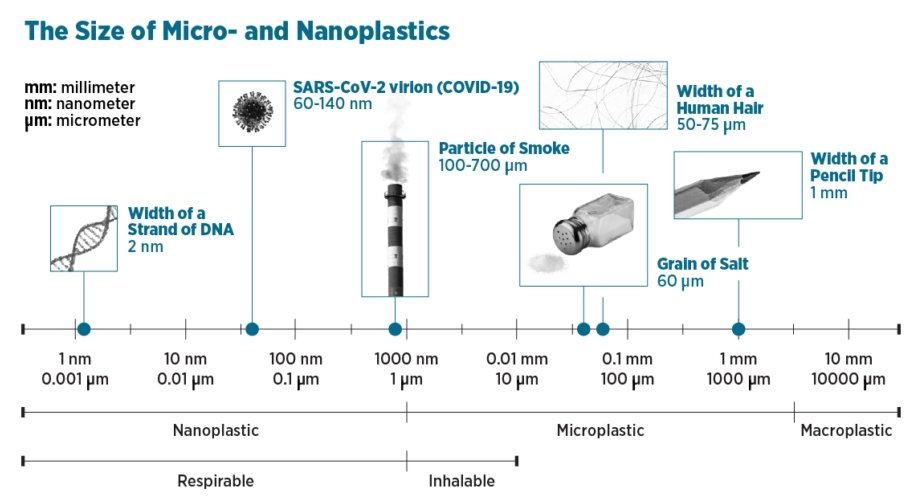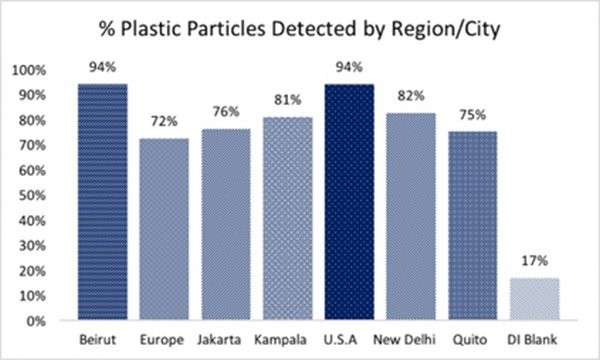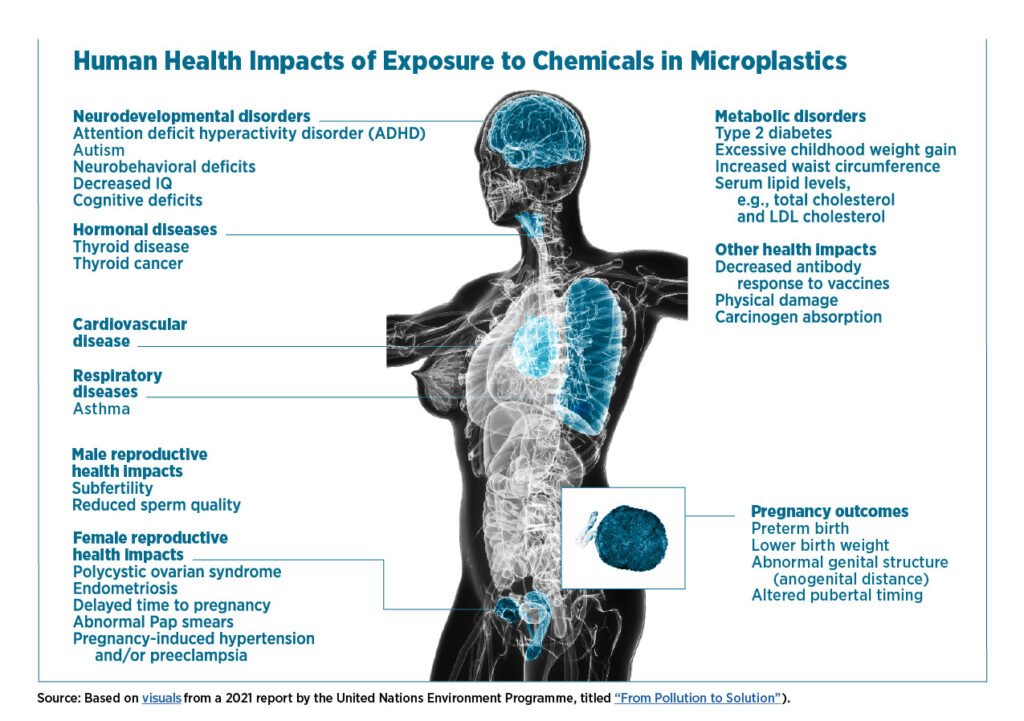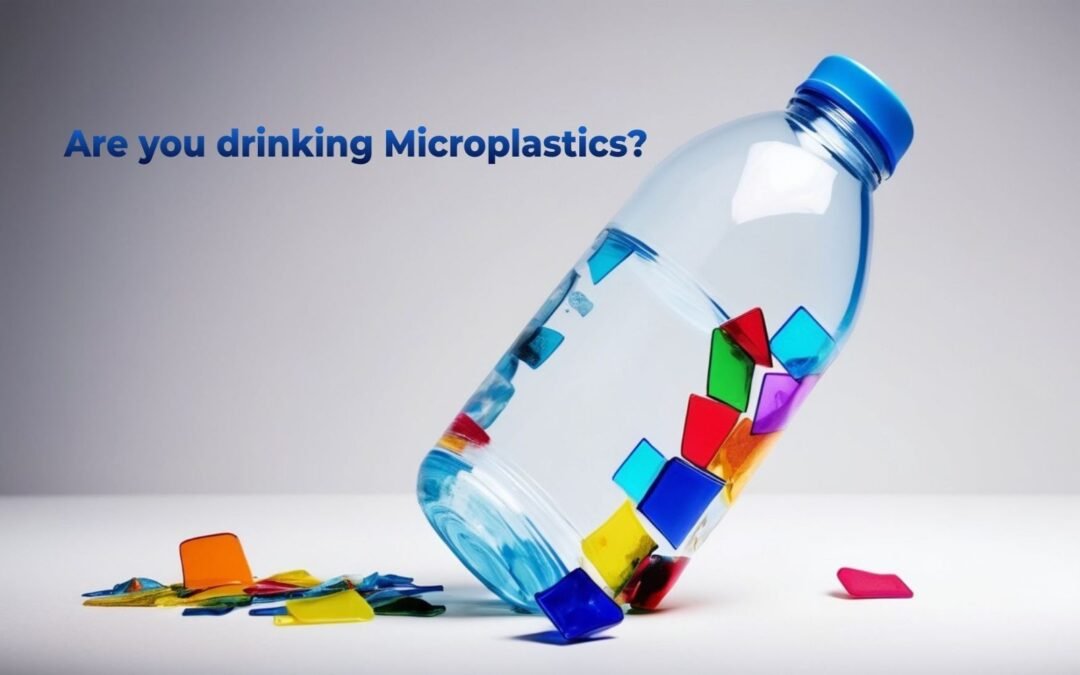Microplastics are plastic fragments of different unique polymer compositions and shapes which measure less than 5 millimeters (0.2 inches). Microplastics are categorized into as primary microplastics and secondary microplastics. Primary microplastics leach directly into the environment while secondary microplastics are by-products of larger primary plastic particles through physical, chemical and biological processes.

Sources of Microplastics In Water
They can come from a variety of sources, both intentional and unintentional, and have the potential to harm aquatic life and even human health. The main sources of microplastics in the environment are mostly:
- Synthetic textiles: The biggest contributor (~35%) to microplastic pollution in the ocean comes from the shedding of microfibers from synthetic clothing, such as polyester, nylon, and acrylic. These fibers are released during washing and can make their way through wastewater treatment plants and into waterways.
- Vehicle tires: As tires wear down, tiny particles of rubber are released into the environment. These particles can be washed into storm drains and eventually end up in rivers, lakes, and oceans.
- Road markings: Paints and plastics used in road markings can break down over time, releasing microplastics into the environment.
- Personal care products: Some cosmetics and personal care products, such as exfoliating scrubs and toothpastes, used to contain microbeads, tiny plastic beads that were later banned in many countries due to environmental concerns. However, microplastics can still be present in other products, such as some facial cleansers and makeup.
- Plastic pellets: These tiny plastic beads are used in the manufacturing of plastic products. Spills and accidents can release pellets into the environment, where they can eventually end up in waterways.
- Marine coatings: Paints used on boats and other marine structures can chip and flake off, releasing microplastics into the water.
- City dust: Microplastics from various sources can accumulate in dust and debris on city streets. This dust can then be washed into storm drains and waterways during rain events.
- Wastewater treatment plants: While wastewater treatment plants can remove some microplastics from sewage, they are not always 100% effective. This means that some microplastics can still be present in treated wastewater that is released into rivers and lakes.
- Plastic bottles and caps: Microplastics can leach from plastic bottles and caps over time, especially if they are exposed to heat or sunlight. This can contribute to microplastic contamination in drinking water.
- Agricultural runoff: Fertilizers and pesticides used in agriculture can contain microplastics, which can then wash into waterways.
Microplastics in Tap Water
A global survey was carried out by Orb Media on tap water from six different regions on five continents. Out of 159 samples analyzed, 83% were found to contain plastic particles. Most of these particles were fibers (99.7%), between 0.1 – 5 mm in length. The range was between 0 and 57 particles per liter, with an overall mean of 4.34 n/L. The highest density of plastic per volume of tap water was found in North America and Lebanon and the lowest densities were found, collectively, in seven European countries.

(source: https://orbmedia.org/invisibles-final-report, 2017)
Microplastics in Bottled Water
While the focus of most past studies has been microplastics; a recent study carried out by researchers from Columbia University in 2024 revealed that, on average, a liter of bottled water in USA included about 240,000 tiny pieces of plastic!! About 90% of these plastic fragments were nanoplastics. This total was 10 to 100 times more plastic particles than seen in earlier studies. They also documented the nature and shape of plastic particles found. Polyethylene terephthalate (PET) was unsurprisingly one of the most common types found since that is what water bottles are made of. Another suggested that the particles are introduced to the water due to abrasion every time you open or close the cap. Contamination may also occur during the water extraction process or through airborne deposition.
Regulatory agencies such as the U.S. Food and Drug Administration (FDA) and the European Food Safety Authority (EFSA) have evaluated the safety of bottled water regarding microplastics. However, there is currently no standardized methodology for assessing and regulating microplastic contamination in bottled water, highlighting the need for further research and regulatory measures to ensure consumer safety.
Increased awareness of microplastic contamination in bottled water has led some consumers to seek alternatives, such as opting for water filters to render tap potable or reusable water bottles made from materials less prone to leaching microplastics.
Health Effects of Microplastics in Water
Plastic, being an inseparable part of our lives, has now been studied to affect our natural ecosystem. As plastic particles become fragmented into microplastics, they can be absorbed through the skin, ingested through the gastrointestinal system or inhaled through the lungs. These microplastics can physically block the digestive system, stimulate the mucous membrane, and injure it. When these microplastics further disintegrate to form ultra small particles called nanoplastics (<100 nanometers), they are able to pass through the primary tissue barrier in the body and penetrate the capillary blood vessel through the blood stream, which can be dispersed throughout the body. Additionally, nanoplastic nanoparticles are hydrophobic in nature and do not dissolve in water but disperse readily. It is a huge concern because its presence has been recently in air samples, food, seawater, drinking water and astoundingly in human breast milk.

A recent study examined Rainbow Trouts that were given food containing microplastics (specifically 15% polypropylene [PP] and 15% polyethylene [PE]) for two months. Researchers found microplastic (PP+PE) toxicity in various parts of the fish, including the muscles, liver, gills, and gastrointestinal tract. The study further found that Hydrogen Rich Water (HRW) had a mitigating effect on the microplastics-mediated toxicity in the fishes’ brain. Hydrogen Rich Water was suggested as a cost effective and eco-friendly curative for the protection of fish from the oxidative damages produced by the ingestion of microplastics.
Currently, Hydrogen Rich Water/Hydrogen Inhalation Therapy has also been considered most beneficial as an adjunct to standard medical treatments even in humans. Read more on the health benefits of hydrogen therapy on humans.
Hydrogen Rich Water is generated through electrolysis. It involves splitting water molecules into hydrogen and oxygen gas using electricity. Machines designed for this purpose are available for purchase and can be used at home!
Removal of Microplastics from water
Several technologies have been developed to remove microplastics from water, aiming to mitigate their environmental impact and potential risks to human health. These technologies employ various physical, chemical, and biological mechanisms to capture and separate microplastic particles from water sources. Here are some notable microplastic removal technologies:
- Filtration: Filtration methods involve passing water through porous materials to physically capture microplastic particles. Common filtration media include sand, activated carbon, and membranes with specific pore sizes tailored to capture microplastics while allowing water molecules to pass through. Ultrafiltration and microfiltration membranes can effectively remove microplastics from water, with pore sizes typically ranging from nanometers to micrometers.
- Coagulation and Flocculation: Coagulation and flocculation processes involve the addition of chemicals, such as aluminum or iron salts, to water to induce the aggregation of microplastic particles into larger clumps or flocs. These flocs can then be separated from the water through sedimentation or filtration processes. Coagulation-flocculation methods are often used in conjunction with other treatment technologies to enhance microplastic removal efficiency.
- Advanced Oxidation Processes (AOPs): AOPs utilize reactive oxygen species, such as ozone, hydrogen peroxide, or ultraviolet (UV) light, to degrade microplastics into smaller fragments or mineralize them into harmless byproducts. These oxidative processes can break down the chemical bonds in plastic polymers, leading to the decomposition of microplastic particles into less harmful substances. AOPs are effective for removing both microplastics and associated organic contaminants from water.
- Electrocoagulation: Electrocoagulation involves the application of an electrical current to water containing microplastic particles, which causes the formation of metal hydroxide complexes that adsorb and precipitate microplastics. This process promotes the coagulation and removal of microplastics through the formation of larger aggregates that can be easily separated from the water. Electrocoagulation is a promising technology for treating water contaminated with microplastics and other suspended solids.
- Biological Treatment: Biological treatment methods utilize microorganisms, such as bacteria and fungi, to degrade or assimilate microplastic particles in water. Certain microbial species have the ability to metabolize plastic polymers as a carbon source, breaking down microplastics into simpler molecules. Biological treatment processes can be integrated into wastewater treatment plants or constructed wetlands to enhance the removal of microplastics and improve water quality.
- Nano-Based Technologies: Nanotechnology-based approaches, such as nanomaterial adsorbents and nanostructured membranes, have shown promise for removing microplastics from water due to their high surface area and adsorption capacity. Nanomaterials, such as graphene oxide, carbon nanotubes, and magnetic nanoparticles, can selectively adsorb microplastic particles from water, facilitating their separation and recovery.
References
- Banerjee, A.; Shelver, W. L. Micro- and Nanoplastic Induced Cellular Toxicity in Mammals: A Review. Sci. Total Environ. 2021, 755, 142518, DOI: 10.1016/j.scitotenv.2020.142518
- Qian et al., 2024 Rapid single-particle chemical imaging of nanoplastics by SRS microscopy. Qian N, Gao X, Lang X, Deng H, Bratu TM, Chen Q, Stapleton P, Yan B, Min W. Proc Natl Acad Sci U S A. 2024 Jan 16;121(3):e2300582121. doi: 10.1073/pnas.2300582121. Epub 2024 Jan 8. PMID: 38190543.
- Schymanski, D., Goldbeck, C., Humpf, H. U., & Fürst, P. (2018). Analysis of microplastics in water by micro-Raman spectroscopy: Release of plastic particles from different packaging into mineral water. Water Research, 129, 154-162.
- EFSA (European Food Safety Authority). (2016). Presence of microplastics and nanoplastics in food, with particular focus on seafood. EFSA Journal, 14(6), e04501.
- Koelmans, A. A., Besseling, E., Wegner, A., & Foekema, E. M. (2013). Plastic as a carrier of POPs to aquatic organisms: A model analysis. Environmental Science & Technology, 47(14), 7812-7820.
- Wagner, M., & Oehlmann, J. (2018). Endocrine disruptors in bottled mineral water: Total estrogenic burden and migration from plastic bottles. Environmental Science and Pollution Research, 25(3), 2456-2463.
- Mason, S. A., Welch, V. G., Neratko, J., & Box, C. (2018). Synthetic polymer contamination in bottled water. Frontiers in Chemistry, 6, 407.
- Jafari, A. J., & Ahmadzadeh, S. (2021). A review on microplastics removal from water by utilizing advanced separation technologies. Chemosphere, 271, 129531.
- Kumar, A., Gao, J., & Zhang, X. (2020). A review of nanotechnology-based approaches for microplastics removal from water. NanoImpact, 20, 100256.
- Ghafari, P., & Hasan, S. W. (2019). A review of technologies for microplastic separation from wastewater. Resources, Conservation and Recycling, 150, 104413.
- Prata, J. C. (2018). Airborne microplastics: consequences to human health?. Environmental pollution, 234, 115-126
- Ragusa, A., Notarstefano, V., Svelato, A., Belloni, A., Gioacchini, G., Blondeel, C., Zucchelli, E., De Luca, C., D’Avino, S., Gulotta, A., Carnevali, O., & Giorgini, E. (2022). Raman Microspectroscopy Detection and Characterisation of Microplastics in Human Breastmilk. Polymers, 14(13), 2700. https://doi.org/10.3390/polym14132700
- https://www.horiba.com/ind/scientific/resources/science-in-action/where-do-microplastics-come-from/ [Accessed on 14/02/2024]
- Kosuth et al., 2017, Synthetic Polymer Contamination in Global Drinking Water. https://orbmedia.org/invisibles-final-report [Accessed on 27/04/2024]
- Atamanalp M.,Kırıcı M.,Köktürk M.,Kırıcı M.,Alwazeer D.,Kocaman E.,Ucar A.,Parlak V.,Özcan S. and Alak G. (2023) Does hydrogen-rich water mitigate MP toxicity in rainbow trout (Oncorhyncus mykiss)? Monitoring with hematology, DNA damage, and apoptosis via ROS/GSH/MDA pathway. Oceanological and Hydrobiological Studies, Vol.52 (Issue 2), pp. 206-220. https://doi.org/10.26881/oahs-2023.2.05

